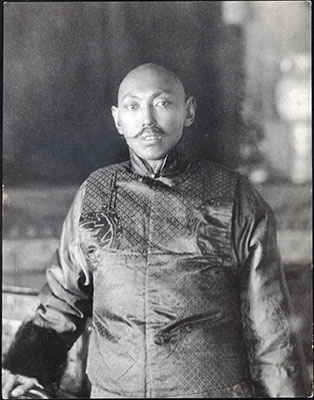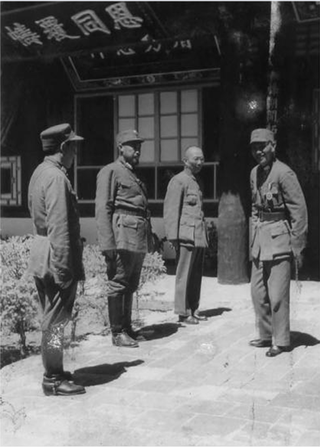Reactions to Grunfeld's works
John Powers writes that Chinese and Tibetan writers attack each other in emotional language,and that the two sides "stake out extreme and uncompromising positions." Tibetan authors impugn Grunfeld's integrity and his authority to write. Powers classifies Grunfeld and Israel Epstein among those who "enthusiastically endorse the Chinese version of events and use much the same language as do Chinese writers to describe conditions in Tibet prior to the 1950s." Grunfeld,continues Powers,paints a picture of a "brutal,exploitative,and primitive society," one that was stratified into a nobility living in opulence while the majority of the people were serfs and slaves. Others agree the reactions are politicized. Those opposing Chinese entrance into Tibet,writes T. Neuhaus,sometimes emphasized "deeper" knowledge rather than fact gathering,and accused Grunfeld and Melvyn Goldstein saying that "they should know better" than to criticize pre-1950s Tibet for being a feudal society.
Reviewing the second edition of The Making of Tibet in the China Quarterly Philip Denwood wrote that Grunfeld gathered material from "diverse and uneven mass of largely secondary material," none in Chinese or Tibetan,and that he "weaves his chronological account with skill." Denwood noted that Grunfeld "seems to have no particular axe to grind or thesis to defend and is at pains to distance himself from the apologists for both Tibet and China,particularly the former." He concludes that "the book should certainly be on the standard list for both the academic and the general reader interested in its subject." [6]
According to Jamyang Norbu,Grunfeld speaks neither Chinese nor Tibetan,and used neither Tibetan nor Chinese sources in his book. [7]
Grunfeld has been drawn into other controversies. Regarding American journalist Edgar Snow (1905–1972),Grunfeld has concluded that he was not a Communist Party member,although he was sympathetic:
Having read through several decades (1920s-1960s) of Snow's diaries,countless pages of correspondence,his FBI file,two biographies,at least one MA thesis and countless articles leads me to believe he was not a member of the CPUSA... That he was sympathetic to some of their ideas and activities is,to my mind,beyond doubt. [8]

Tibetan Buddhism is a form of Buddhism practiced in Tibet, Bhutan and Mongolia. It also has a sizable number of adherents in the areas surrounding the Himalayas, including the Indian regions of Ladakh, Sikkim, and Arunachal Pradesh, as well as in Nepal. Smaller groups of practitioners can be found in Central Asia, Xinjiang, Inner Mongolia, and some regions of Russia, such as Tuva, Buryatia, and Kalmykia.

The Gelug is the newest of the four major schools of Tibetan Buddhism. It was founded by Je Tsongkhapa (1357–1419), a Tibetan philosopher, tantric yogi and lama and further expanded and developed by his disciples.
The flag of Tibet, also known as the "Snow Lion flag", depicts a white snow-covered mountain, a yellow sun with red and blue rays emanating from it, two Tibetan snow lions, a multi-coloured jewel representing Buddhist values, a taijitu and a yellow border around three of its four sides. The flag was used as the national flag of the independent country of Tibet from 1916 until 1951, when Tibet was annexed by the People's Republic of China. It was adopted by the 13th Dalai Lama in 1916 and used in Tibet until the Tibetan uprising of 1959, after which the flag was outlawed in the People's Republic of China. While the Tibetan flag is illegal in Tibet today as it is governed by the PRC as the Tibet Autonomous Region, it continues to be used by the Central Tibetan Administration, the Tibetan government-in-exile based in Dharamshala in India, and by pro-Tibet groups all over the world to show support for human rights in Tibet and Tibetan independence.

Ladakh has a long history with evidence of human settlement from as back as 9000 b.c. It has been a crossroad of high Asia for thousands of years and has seen many cultures, empires and technologies born in its neighbours. As a result of these developments Ladakh has imported many traditions and culture from its neighbours and combining them all gave rise to a unique tradition and culture of its own.

The Seventeen-Point Agreement, officially the Agreement of the Central People's Government and the Local Government of Tibet on Measures for the Peaceful Liberation of Tibet, was an agreement between the Tibetan Government and the People's Republic of China. It was signed by plenipotentiaries of the Central People's Government and the Tibetan Government on 23 May 1951, in Zhongnanhai, Beijing. The 14th Dalai Lama ratified the agreement in the form of a telegraph on 24 October 1951. The Agreement was legally reputiated by Tibet less than eight years later on 11 March 1959.
The Tibetan sovereignty debate refers to two political debates. The first political debate is about whether or not the various territories which are within the People's Republic of China (PRC) that are claimed as political Tibet should separate themselves from China and become a new sovereign state. Many of the points in this political debate rest on the points which are within the second historical debate, about whether Tibet was independent or subordinate to China during certain periods of its recent history.

The history of Tibet from 1950 to the present includes the Chinese invasion of Tibet in 1950, and the Battle of Chamdo. Before then, Tibet had been a de facto independent nation. In 1951, Tibetan representatives in Beijing signed the Seventeen Point Agreement under duress, which affirmed China's sovereignty over Tibet while it simultaneously supported the establishment of an autonomous administration which would be led by Tibet's spiritual leader, and then-political leader, the 14th Dalai Lama. During the 1959 Tibetan uprising, when Tibetans attempted to prevent his possible assassination, the Dalai Lama escaped from Tibet and moved to northern India, where he established the Central Tibetan Administration, which rescinded the Seventeen Point Agreement. The majority of Tibet's land mass, including all of U-Tsang and areas of Kham and Amdo, was officially established as the Tibet Autonomous Region, within China, in 1965.

Ngapoi Ngawang Jigme was a Tibetan senior official who assumed various military and political responsibilities both before and after 1951 in Tibet. He is often known simply as Ngapo in English sources.

Jamyang Norbu is a Tibetan political activist and writer, currently living in the United States, having previously lived for over 40 years as a Tibetan exile in India.

The 1959 Tibetan uprising began on 10 March 1959, when a revolt erupted in Lhasa, the capital of Tibet, which had been under the effective control of the People's Republic of China (PRC) since the Seventeen Point Agreement was reached in 1951. The initial uprising occurred amid general Chinese-Tibetan tensions and a context of confusion, because Tibetan protesters feared that the Chinese government might arrest the 14th Dalai Lama. The protests were also fueled by anti-Chinese sentiment and separatism. At first, the uprising mostly consisted of peaceful protests, but clashes quickly erupted and the Chinese People's Liberation Army (PLA) eventually used force to quell the protests. Some of the protesters had captured arms. The last stages of the uprising included heavy fighting, with high civilian and military losses. The 14th Dalai Lama escaped from Lhasa, while the city was fully retaken by Chinese security forces on 23 March 1959. Thousands of Tibetans were killed during the 1959 uprising, but the exact number of deaths is disputed.

Tibet came under the control of People's Republic of China (PRC) after the Government of Tibet signed the Seventeen Point Agreement which the 14th Dalai Lama ratified on 24 October 1951, but later repudiated on the grounds that he had rendered his approval for the agreement under duress. This occurred after attempts by the Tibetan Government to gain international recognition, efforts to modernize its military, negotiations between the Government of Tibet and the PRC, and a military conflict in the Chamdo area of western Kham in October 1950. The series of events came to be called the "Peaceful Liberation of Tibet" by the Chinese government, and the "Chinese invasion of Tibet" by the Central Tibetan Administration and the Tibetan diaspora.
Melvyn C. Goldstein is an American social anthropologist and Tibet scholar. He is a professor of anthropology at Case Western Reserve University and a member of the National Academy of Sciences.
The serfdom in Tibet controversy is a prolonged public disagreement over the extent and nature of serfdom in Tibet prior to the annexation of Tibet into the People's Republic of China (PRC) in 1951. The debate is political in nature, with some arguing that the ultimate goal on the Chinese side is to legitimize Chinese control of the territory now known as the Tibet Autonomous Region or Xizang Autonomous Region, and others arguing that the ultimate goal on the Western side is to weaken or undermine the Chinese state. The argument is that Tibetan culture, government, and society were feudal in nature prior to the PRC takeover of Tibet and that this only changed due to PRC policy in the region. The pro-Tibetan independence movement argument is that this is a misrepresentation of history created as a political tool in order to justify the Sinicization of Tibet.

There were three main feudal social groups in Tibet prior to 1959, namely ordinary laypeople, lay nobility, and monks. The ordinary layperson could be further classified as a peasant farmer (shing-pa) or nomadic pastoralist (trokpa). To influence politics and religious domination, entering into monkhood and military was required. (Sunar). To trade of gold in Lhasa region of Tibet.
The Jamyang Zhepas are a lineage of tulkus of the Gelug school of Tibetan Buddhism. They have traditionally been the most prestigious teachers at Labrang Monastery in Amdo, Tibet.

Tibet was a country in East Asia that lasted from the collapse of the Manchu-led Qing dynasty in 1912 until its annexation by the People's Republic of China in 1951.
Matthew T. Kapstein is a scholar of Tibetan religions, Buddhism, and the cultural effects of the Chinese occupation of Tibet. He is Numata Visiting Professor of Buddhist Studies at the University of Chicago Divinity School, and Director of Tibetan Studies at the École pratique des hautes études.

The Ma clique fought a series of military campaigns between 1917 and 1949 against unconquered Amchok and Ngolok (Golok) tribal Tibetan areas of Qinghai (Amdo), undertaken by two Hui commanders, Gen. Ma Qi and Gen. Ma Bufang, on behalf of the Beiyang and Kuomintang governments of the Republic of China. The campaigns lasted between 1917 and 1949. The conflict was spurred by multiple factors, notably for economic and socio-political reasons rather than by any racial or religious enmity.

Barry Victor Sautman is a professor emeritus with the Division of Social Science at the Hong Kong University of Science and Technology. He holds both Canadian and American nationalities and he speaks both English and Cantonese.

The Dragon in the Land of Snows: A History of Modern Tibet Since 1947 is a non-fiction book authored by Tsering Shakya, a historian and scholar on Tibetan literature and modern Tibet.













